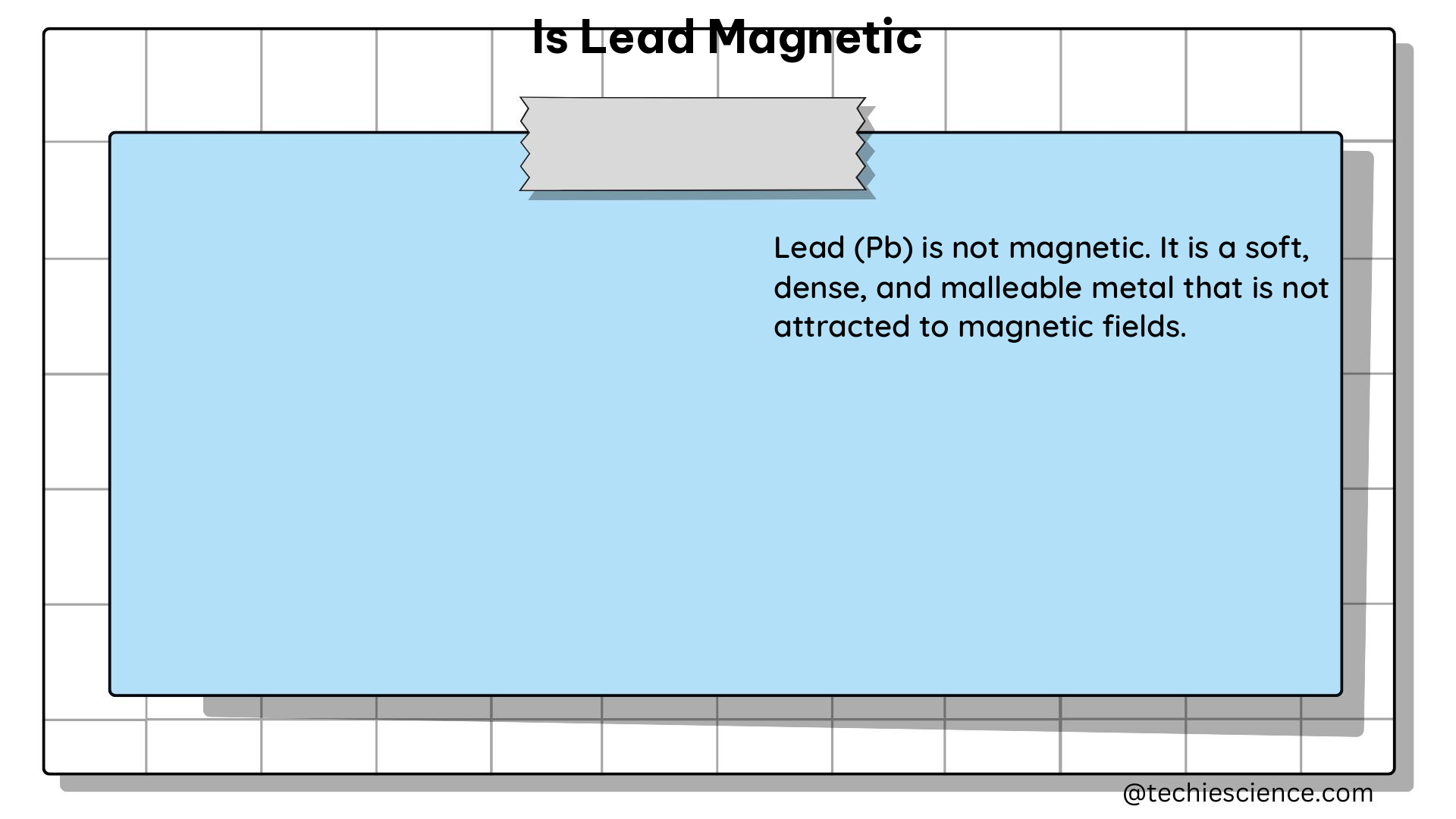Summary
Lead is a dense, soft, and malleable metal that has been used for various applications throughout history. One of the common questions about lead is whether it is magnetic or not. In this comprehensive guide, we will delve into the magnetic properties of lead and explore the scientific principles behind it, providing a detailed understanding for physics students.
Understanding the Magnetic Properties of Lead

Lead is a non-ferromagnetic material, which means it does not exhibit strong magnetic properties like iron, nickel, or cobalt. The magnetic behavior of a material is primarily determined by the arrangement and spin of its electrons.
Atomic Structure and Electron Configuration of Lead
Lead (Pb) has an atomic number of 82 and an electronic configuration of [Xe] 4f^14 5d^10 6s^2 6p^2. The outermost electrons in the 6s and 6p orbitals are responsible for the chemical and physical properties of lead, including its non-magnetic behavior.
Diamagnetism in Lead
Lead is classified as a diamagnetic material, which means that when placed in an external magnetic field, it produces a weak magnetic field in the opposite direction. This is due to the paired electrons in the lead atom, which have their magnetic moments canceled out, resulting in a net zero magnetic moment.
The diamagnetic behavior of lead can be quantified using the magnetic susceptibility, which is a measure of the material’s response to an applied magnetic field. The magnetic susceptibility of lead is approximately -1.9 × 10^-9 m^3/kg, indicating its weak diamagnetic properties.
Comparison with Ferromagnetic Materials
In contrast to lead, ferromagnetic materials like iron, nickel, and cobalt have unpaired electrons in their atomic structure, which results in a net magnetic moment. These materials can be magnetized and exhibit strong magnetic properties, making them suitable for various applications, such as in electric motors, transformers, and data storage devices.
Applications and Implications of Lead’s Non-Magnetic Behavior
The non-magnetic nature of lead has several practical implications and applications:
-
Shielding from Electromagnetic Radiation: Lead’s high density and ability to absorb electromagnetic radiation make it an effective material for shielding against X-rays, gamma rays, and other forms of ionizing radiation. This property is utilized in medical and nuclear applications, where lead is used to protect personnel and equipment.
-
Electrical and Electronic Applications: Lead’s non-magnetic behavior allows it to be used in various electrical and electronic applications without interfering with the operation of nearby magnetic components. This includes its use in electrical cables, batteries, and some electronic devices.
-
Corrosion Resistance: Lead’s non-magnetic nature, combined with its high corrosion resistance, makes it suitable for use in environments where corrosion is a concern, such as in the construction of chemical storage tanks and water pipes.
-
Ballistic Applications: The high density and non-magnetic properties of lead make it a preferred material for use in ammunition, particularly in the production of bullets and projectiles.
-
Artistic and Decorative Applications: Lead’s malleability and non-magnetic properties have also led to its use in artistic and decorative applications, such as in stained glass windows and lead-based paints.
Practical Considerations and Precautions
While lead is a versatile material with many applications, it is important to note that it is also a toxic substance, particularly when inhaled or ingested. Proper safety measures and handling protocols must be followed when working with lead to minimize the risk of exposure and potential health hazards.
Conclusion
In summary, lead is a non-ferromagnetic material that exhibits diamagnetic behavior, meaning it produces a weak magnetic field in the opposite direction of an applied external magnetic field. This property is a result of the paired electrons in the lead atom, which cancel out their magnetic moments. Understanding the magnetic properties of lead is crucial for various applications, from shielding against radiation to its use in electrical and electronic devices. By exploring the scientific principles behind lead’s non-magnetic behavior, physics students can gain a deeper appreciation for the practical implications and applications of this versatile metal.
References:
- Cullity, B. D., & Graham, C. D. (2008). Introduction to Magnetic Materials. Wiley-IEEE Press.
- Jiles, D. (1998). Introduction to Magnetism and Magnetic Materials. CRC Press.
- Kittel, C. (2005). Introduction to Solid State Physics. Wiley.
- Tipler, P. A., & Mosca, G. (2008). Physics for Scientists and Engineers. W. H. Freeman.
- Zahn, M. (1979). Electromagnetic Field Theory: A Problem Solving Approach. Wiley.
I am Keerthi K Murthy, I have completed post graduation in Physics, with the specialization in the field of solid state physics. I have always consider physics as a fundamental subject which is connected to our daily life. Being a science student I enjoy exploring new things in physics. As a writer my goal is to reach the readers with the simplified manner through my articles.